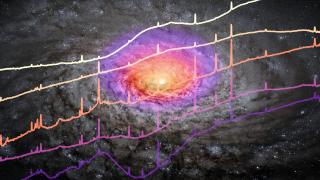Bibcode
Walsh, J. R.; Monreal-Ibero, A.; Barlow, M. J.; Ueta, T.; Wesson, R.; Zijlstra, A. A.; Kimeswenger, S.; Leal-Ferreira, M. L.; Otsuka, M.
Referencia bibliográfica
Astronomy and Astrophysics, Volume 620, id.A169, 25 pp.
Fecha de publicación:
12
2018
Revista
Número de citas
27
Número de citas referidas
24
Descripción
Aims: The spatial structure of the emission lines and continuum
over the 50″ extent of the nearby, O-rich, PN NGC 7009 (Saturn
Nebula) have been observed with the MUSE integral field spectrograph on
the ESO Very Large Telescope. This study concentrates on maps of line
emission and their interpretation in terms of physical conditions. Methods: MUSE Science Verification data, in <0.6″ seeing,
have been reduced and analysed as maps of emission lines and continuum
over the wavelength range 4750-9350 Å. The dust extinction, the
electron densities and temperatures of various phases of the ionized
gas, abundances of species from low to high ionization and some total
abundances are determined using standard techniques. Results:
Emission line maps over the bright shells are presented, from neutral to
the highest ionization available (He II and [Mn V]). For collisionally
excited lines (CELs), maps of electron temperature (Te from
[N II] and [S III]) and density (Ne from [S II] and [Cl III])
are available and for optical recombination lines (ORLs) temperature
(from the Paschen jump and ratio of He I lines) and density (from high
Paschen lines). These estimates are compared: for the first time, maps
of the differences in CEL and ORL Te's have been derived, and
correspondingly a map of t2 between a CEL and ORL
temperature, showing considerable detail. Total abundances of only He
and O were formed, the latter using three ionization correction factors.
However, the map of He/H is not flat, departing by 2% from a constant
value, with remnants corresponding to ionization structures. An
integrated spectrum over an area of 2340 arcsec2 was also
formed and compared to 1D photoionization models. Conclusions:
The spatial variation of a range of nebular parameters illustrates the
complexity of the ionized media in NGC 7009. These MUSE data are very
rich with detections of hundreds of lines over areas of hundreds of
arcsec2 and follow-on studies are outlined.
Based on observations collected at the European Organisation for
Astronomical Research in the Southern Hemisphere, Chile in Science
Verification (SV) observing proposal 60.A-9347(A).FITS files of all the
individual maps are only available at the CDS via anonymous ftp to http://cdsarc.u-strasbg.fr
(ftp://130.79.128.5) or via http://cdsarc.u-strasbg.fr/viz-bin/qcat?J/A+A/620/A169
Proyectos relacionados

Actividad Nuclear en Galaxias: una Perspectiva 3D del Núcleo y su Entorno
Nuestro proyecto puede dividirse en dos líneas principales de investigación. En primer lugar, el estudio de los vientos producidos por cuásares luminosos oscurecidos y del impacto que estos tienen en sus galaxias anfitrionas (retroalimentación del AGN). Para ello hemos obtenido observaciones en el óptico e infrarrojo cercano con el Gran Telescopio
Cristina
Ramos Almeida